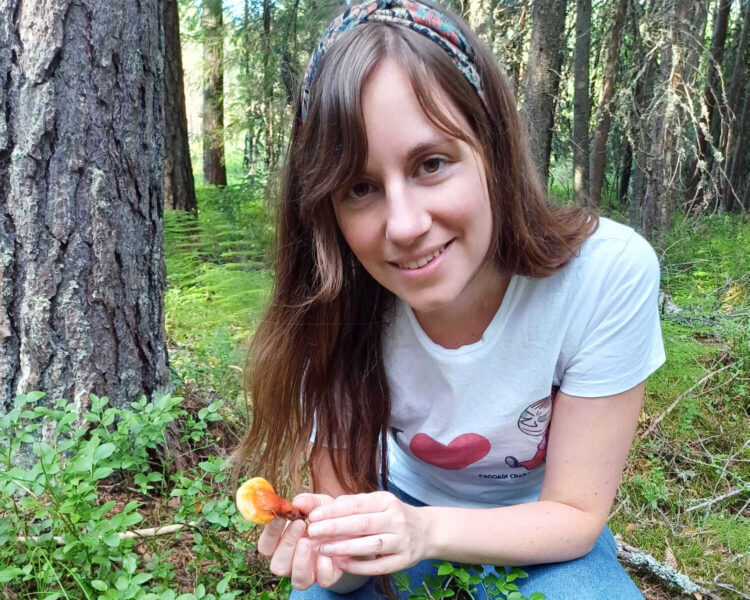Spanish scientist inspired by wood industry sidestreams – commercially interesting mushrooms grow in sawdust

It needed somebody from Spain, namely Marta Cortina-Escribano, to show that sawdust and chips from aspen and birch can be used to grow the Ganoderma lucidum mushroom.
Sawdust and wood chips are sidestreams of the wood processing industry. Ganoderma lucidum, variously known in English as varnished conk, lacquered bracket, or ling chih, but perhaps most often as reishi, is among the world’s most important speciality mushrooms. It is likely to possess health benefits, which could actually be further enhanced during Marta Cortina-Escribano’s doctoral research.
Cortina-Escribano’s doctoral thesis ’Selective breeding and taxonomy of laccate Ganoderma species originating from Finland’ was examined at the University of Eastern Finland in December 2024. The work received the thesis prize awarded annually by the Finnish Natural Resources Research Foundation.
’The research promotes the value-adding use of Finnish wood materials in line with the principles of bio- and circular economy,’ stated the Finnish Natural Resources Research Foundation on the grounds for awarding the prize.
In addition, Cortina-Escribano’s research showed that while material from pine was not ideal for cultivating the fungus, reishi fermentation decreased the lignin content of pine, which may be of interest to the pulp industry.
Attracted by Finnish nature and the university
Marta Cortina-Escribano was a student of environmental sciences at the University of Valencia. She was keen to also study abroad and to learn about environments and cultures different from her native Spain. She ended up in Joensuu, having heard favourable reports about the University of Eastern Finland and the nature around Joensuu.
’My colleagues told me many good things about Finland, the Finnish university system and the natural environment. I decided I’d have to see all this for myself, and I was not disappointed,’ she says.
Cortina-Escribano was especially attracted by the Finns’ close relationship to forests, and this led her to the Master’s programme in forest, energy and wood technology at the University of Eastern Finland. Nevertheless, her research interest did not focus on wood-based products.
Cortina-Escribano was inspired by the plentiful sidestreams from the Finnish wood-processing industry which might be used in cultivating speciality mushrooms, such as reishi. The mushroom has also been found to occur naturally in Finland.
’Cultivating local fungus strains using local materials could be a way of expanding the range of other than wood-based products from Finnish forests,’ Cortina-Escribano remembers thinking.

Inspired by applied mycology
Cortina-Escribano realized that what really inspired her was applied mycology, or the study of fungi. The path towards a doctoral thesis began to open up.
’I was particularly interested in the role of fungi in developing new value chains. I got to know Henri Vanhanen, who became my thesis supervisor and was then leading a project at Natural Resources Institute Finland, which collected Finnish fungus strains and cultivated speciality fungi using sidestreams from the forest industry,’ she says.
At Natural Resources Institute Finland (Luke for short), Cortina-Escribano was able to work with an extensive collection of Finnish fungus species, which also included reishi.
’I was captivated by the study of fungus cultivation, so I decided to make it the topic of my thesis,’ she says.
However, the cultivation was anything but easy.
’I soon saw that fungi don’t behave at all as you would expect. The results were in conflict with what I’d thought. In general, that was exciting, but I must admit having also been frustrated,’ she laughs.
First reishi was a source of delight
The first milestone of the thesis research was when the cultivation efforts produced the first reishi, which saw the light of day at Luke’s laboratory in Joensuu.
’I can remember how jubilant I felt on finding a tiny reishi fruiting body in one of the bags in the substrate. It was the first successfully cultivated fungus. It smelt so good and fresh. I was lucky that this happened right at the start of my doctoral research, because it motivated me and encouraged me to optimize the cultivation parameters for the following experiments,’ says Cortina-Escribano.
Because of reishi, the researcher also had to spend time in forests despite mosquitoes and blackflies.
’The mosquitoes whined around me and bit me. I did as my mother advised me and treated the itch with garlic. I wasn’t really convinced about it, but anyway, at times I walked about in the forest reeking of garlic and still surrounded by mosquitoes. Wonderful!’ she laughs.
One summer’s day, Cortina-Escribano found a wild reishi in the forest.
’The sun was shining, it was over 22 degrees Celsius, and I was walking in a spruce forest. I’d been tipped that something resembling reishi might grow here. I just had to go and check. I was surrounded by a cloud of mosquitoes, and then, in all that green, I could see a flash of something reddish brown and shiny. I ran towards it. I smiled and whooped. A wild reishi! I took a selfie with the fungus and sent it to my family in Spain,’ she says.
Commercial potential of reishi
There is a commercial potential in reishi. According to Cortina-Escribano, it is widely used, especially in Asia, as a dietary supplement and in the food, feed and cosmetics industries.
In recent years, reishi has been used in wood-based materials in the construction, packaging and textile industries. Cortina-Escribano’s research provides data to help with processing the fungus into high-value bio-based products, using forest industry sidestreams.
The demand for reishi products is increasing not just in Asia, but also in Europe and North America. Most of the production takes place in East Asian countries, where the most frequent substrate medium is sawdust.